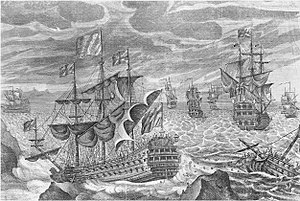HMS Association (1697)

An 18th-century engraving of the Scilly naval disaster, with HMS Association in the centre
|
|
| History | |
|---|---|
|
|
|
| Name: | Association |
| Ordered: | 20 December 1694 |
| Builder: | Bagwell, Portsmouth Dockyard |
| Launched: | 1 January 1697 |
| Commissioned: | July 1697 |
| Fate: | Wrecked, 22 October 1707 (OS) |
| General characteristics | |
| Class and type: | 90-gun second-rate ship of the line |
| Tons burthen: | 1459 32⁄94bm |
| Length: | 165 ft (50.3 m) (gundeck) |
| Beam: | 45 ft 4 in (13.8 m) |
| Depth of hold: | 18 ft 3 in (5.6 m) |
| Propulsion: | Sails |
| Sail plan: | Full rigged ship |
| Complement: | 800 officers and men (approx.) |
| Armament: |
|
Association was a 90-gun second-rate ship of the line of the Royal Navy, launched at Portsmouth Dockyard in 1697. She served with distinction at the capture of Gibraltar, and was lost in 1707 by grounding on the Isles of Scilly in the greatest maritime disaster of the age.
Association survived the Great Storm of 1703, during which she was at anchor off Harwich. Her rigging was cut away to avoid foundering on the "Galloper" sandbar, and she was blown to Gothenburg in Sweden before she could make her way back to England.
Association served as the flagship of Admiral Sir Cloudesley Shovell in the Mediterranean during the War of the Spanish Succession. Her engagements included the capture of Gibraltar on 21 July 1704, and the Battle of Toulon in summer 1707.
In October 1707, Association, commanded by Captain Edmund Loades and with Admiral Shovell on board, was returning from the Mediterranean after the Toulon campaign. The 21 ships in the squadron entered the mouth of the English Channel on the night of 22 October 1707 (Old style). At 8 pm, Association struck the Outer Gilstone Rock (see image) off the Isles of Scilly, and was wrecked with the loss of her entire crew of about 800 men. As a result of navigational errors, the ships were not where they were reckoned to be. Association was seen by those on board HMS St George to go down in three or four minutes' time. Among the dead were Captain Loades and Admiral Shovell, his stepsons Sir John Narborough and James Narborough (sons of Shovell's wife from her marriage to Rear Admiral Sir John Narbrough) as well as Henry Trelawney, second son of the Bishop of Winchester. Captain Loades was the son of Rear Admiral Narbrough's sister. Three other ships (HMS Eagle, HMS Romney and HMS Firebrand) were also lost, bringing the death toll to nearly 2,000. The Scilly naval disaster was one of the greatest maritime disasters in British history. It was largely as a result of this disaster that the Board of the Admiralty instituted a competition for a more precise method to determine longitude. There is an impressive memorial depicting the sinking of the Association in the church at the Narboroughs' home of Knowlton near Dover.
...
Wikipedia
